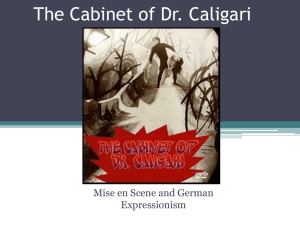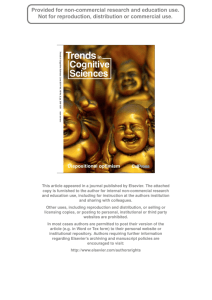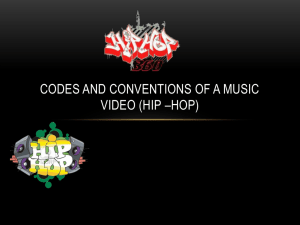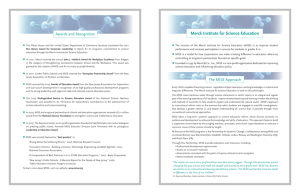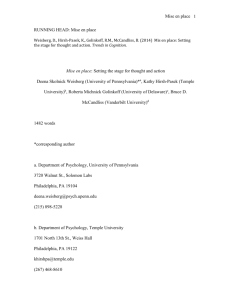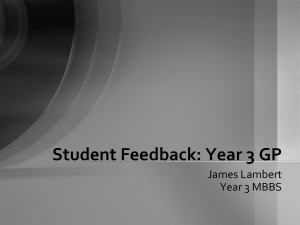Mise-en
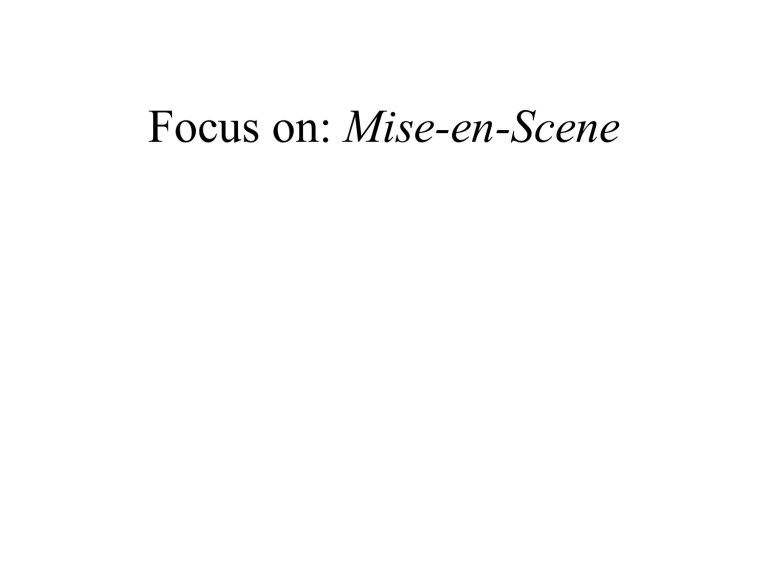
Focus on:
Mise-en-Scene
Mise-en-Scene
From the French, literally translates to ‘put on the stage’ or ‘placed within the scene’… however, deals with a number of issues overlapping with cinematography that can categorized.
Working definition of
Mise-en-
Scene . . .
The arrangement and relationships of visual weights and movements within the frame and outside of the frame.
Incorporates both the staging of action and the way it is recorded and presented; i.e., both production and product.
Elements of
Mise-en-Scene
• Dominant
• Subsidiary contrasts
• Cinematography
• Open and closed form
• Frame composition and design
• Character placement and proxemics
• What’s dominant? What captures our attention initially?
• What do you notice second and third?
• How does the eye travel around the frame, often from point to point?
Mise . . . What’s dominant and secondary?
• Characters’ eyes can direct our attention
• Characters place in the front and center gain more attention than on sides or back
• Heighth, lighting, and colors demand attention
• Dominance can be read literally and figuratively
Mise
includes elements of cinematography…
You might consider how elements of cinematography properly involve how the film is recorded and mise involves what is recorded. That is, cinematography is the production and mise is the product.
Elements of
Mise
. . .
• Dominant
• Subsidiary contrasts
• Cinematography
• Open and closed form
• Frame composition and design
• Character placement and proxemics
Quick review: Cinematography includes…
• Lighting
• Color (formally)/Contrast
• Film stocks & gauges
• Opticals (lenses, filters)
• Effects
• Shots*
(reviewing…) and we define shots according to:
• Size/Distance
• Angle
• Content
• Movement
• Point of view
• Conventions
Elements of
Mise
. . .
• Dominant
• Subsidiary contrasts
• Cinematography
• Open and closed form
• Frame composition and design
• Character placement and proxemics
Open form . . .
• Tends toward realistic film expressions
• Apparent haphazard frame composition
• Temporarily cuts off action and space; action continues offscreen
( Alien )
Open form manipulates the film form, which suggests vastness, loneliness and isolation, desolation here in Alien
Closed form . . .
• Tends toward formalistic film expressions
• Distortion of form over subject as content
• Self-conscious style of presentation
• Balanced, figurative design
Closed form manipulates the film form, often to cerate an organized space in which the action takes place--the frame as a sort of stage. Note the blocking devices. ( Lord of the Rings )
Elements of
Mise
. . .
• Dominant
• Subsidiary contrasts
• Cinematography
• Open and closed form
• Frame composition and design
• Character placement and proxemics
Mise
involves frame composition and design . . .
• How tightly or loosely organized are objects and characters within the frame?
• How balanced is the frame?
• What depths does the frame provide?
• What is the underlying design of the frame?
Classic “S-shaped” or triangular? Linear?
Mise
involves the placement of characters . . .
• How much space between characters and specific objects?
• Public, social, personal, and intimate distance
• Characters’ relationships to camera create perspective and other meanings
What does Austin’s placement suggest about his feelings for the other characters?
Mise . . . Compare the placement of these characters. What do we know about them and their relationships?
Mise
. . . Character placement
• When characters touch, there is some form of intimacy
• Intimacy, though, does not have to be ‘loving”
• Intimacy can be protective or mutually trusting or even violent
Mise
. . . placement creates dominance . . .
• Front is more dominant than back
• Center more than sides
• Bigger more than smaller
• Moving more than static
• Human more than non-human
• Standing more than sitting
• Follow eye-line matches
Elements of
Mise
. . .
• Dominant
• Subsidiary contrasts
• Cinematography
• Open and closed form
• Frame composition and design
• Character placement and proxemics
